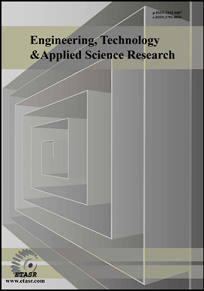Enhancing the Scalability of Blockchain Networks using a Data Partitioning Technique
Received: 16 August 2024 | Revised: 15 September 2024 | Accepted: 19 September 2024 | Online: 26 September 2024
Corresponding author: Niranjan C. Kundur
Abstract
The scalability limitations of current blockchain systems slow down their broad adoption. This issue arises because transactions are processed sequentially, limiting throughput and increasing network delays. Additionally, even with advanced multicore technology, the Proof-of-Work (PoW) process is generally performed in a linear fashion. To address these challenges, this study proposes a static analysis-based data partitioning technique to enhance transaction performance and reduce network latency by allowing parallel processing of transactions, called Simultaneous Block-Level Transaction Execution in a Distributed Setting. This framework utilizes a master-slave system within a trusted node community. The master node analyzes transactions and partitions non-conflicting ones into separate groups, or shards, which are then distributed among slave nodes for parallel execution. Once transactions are completed, the community's combined computing power is used to perform PoW simultaneously. The miner subsequently broadcasts the newly created block to other network peers for validation, which can be performed either sequentially or in parallel. Validators ensure that they achieve the same state as specified in the block. Implementing this framework on a workload can result in a maximum speedup of 1.81x for miners and 1.80x for validators, with each block containing between 150 and 550 transactions and involving six community members. PoW is a consensus mechanism in which miners solve complex cryptographic puzzles to validate transactions. It ensures network security but is resource-intensive due to its high computational demands. In the proposed framework, the master node coordinates transactions, while the slave nodes process them in parallel. This approach maximizes resource utilization across nodes.
Keywords:
blockchain scalability, data partitioning, parallel transaction processing, network latency, Proof of Work (PoW)Downloads
References
Yizhong Liua, Jianwei Liua, Marcos Antonio Vaz Salles: Building Blocks of Sharding Blockchain Systems: Concepts, Approaches, and Open Problems, (2021)
Hung Dang, Tien Tuan Anh Dinh, Dumitrel Loghin Ee-Chien Chang: Towards Scaling Blockchain Systems via Sharding, (2019).
Deepal Tennakoon, Vincent Gramoli: Dynamic Blockchain Sharding, (2022).
Gang Wang, Zhijie Jerry Shi, Mark, NixonSong Ha: SoK: Sharding on Blockchain, (2019).
Dhulavvagol, P. M., Bhajantri, V. H., & Totad, S. G. (2020). Blockchain ethereum clients performance analysis considering E-voting application. Procedia Computer Science, 167, 2506-2515.
Christian Decker, Jochen Seidel, and Roger Wattenhofer. Bitcoin meets strong consistency. In Proceedings of the 17th International Conference on Distributed Computing and Networking, ICDCN ’16, pages 13:1–13:10. ACM, 2016
Christian Decker, Jochen Seidel, and Roger Wattenhofer. Bitcoin meets strong consistency. In Proceedings of the 17th International Conference on Distributed Computing and Networking, ICDCN ’16, pages 13:1–13:10. ACM, 2016.
Alethio. Are miners centralized? a look into mining pools. https://media.consensys.net/ are-miners-centralized-a-look-into-mining-pools-b594425411dc. [Online; accessed 17-5-2019].
Dhulavvagol, Praveen M., and S. G. Totad. "Performance enhancement of distributed system using HDFS federation and sharding." Procedia Computer Science 218 (2023): 2830-2841.
P. S. Anjana, S. Kumari, S. Peri, S. Rathor, and A. Somani, “An efficient framework for optimistic concurrent execution of smart contracts,” in 27th Euromicro International Conference on Parallel, Distributed and Network-Based Processing (PDP), Feb 2019, pp. 83–92.
Zhang and K. Zhang, “Enabling concurrency on smart contracts using multiversion ordering,” in Web and Big Data, Y. Cai, Y. Ishikawa, and J. Xu, Eds., Cham, 2018, pp. 425–439.
P. M. Dhulavvagol, S. G. Totad and N. Bhandage, "Topic Based Partitioning for Selective Search Using Sharding Technique," 2022 International Conference for Advancement in Technology (ICONAT), Goa, India, 2022, pp. 1-5, doi: 10.1109/ICONAT53423.2022.9726020.
Shimal SH Taher, Siddeeq Y. Ameen, Jihan A. Ahmed S G: Advanced Fraud Detection in Blockchain Transactions: An Ensemble learning and Explainable AI Approach, " Engineering, Technology & Applied Science Research, vol. 14,Issue1, pp. 12822–12830, Feb. 2024, https://doi.org/10.48084/etasr.6641
I. Purdon and E. Erturk, “Perspectives of Blockchain Technology, its Relation to the Cloud and its Potential Role in Computer Science Education”, Eng. Technol. Appl. Sci. Res., vol. 7, no. 6, pp. 2340–2344, Dec. 2017. https://doi.org/10.48084/etasr.1629
E. Aruna and A. Sahayadhas, “Blockchain-Inspired Lightweight Dynamic Encryption Schemes for a Secure Health Care Information Exchange System”, Eng. Technol. Appl. Sci. Res., vol. 14, no. 4, pp. 15050–15055, Aug. 2024. https://doi.org/10.48084/etasr.7390
A. Barredo Arrieta et al., "Explainable Artificial Intelligence (XAI): Concepts, taxonomies, opportunities and challenges toward responsible AI," Information Fusion, vol. 58, pp. 82–115, Jun. 2020, https://doi.org/10.1016/j.inffus.2019.12.012.
B. Mahbooba, M. Timilsina, R. Sahal, and M. Serrano, "Explainable Artificial Intelligence (XAI) to Enhance Trust Management in Intrusion Detection Systems Using Decision Tree Model," Complexity, vol. 2021, Jan. 2021, Art. no. e6634811, https://doi.org/10.1155/2021/6634811
Downloads
How to Cite
License
Copyright (c) 2024 Basavaiah Lathamani, Niranjan C. Kundur, Chaya J. Swamy, Pavana Kumari Hanumanthaiah, Praveen M. Dhulavvagol, Bellary Chiterki Anil

This work is licensed under a Creative Commons Attribution 4.0 International License.
Authors who publish with this journal agree to the following terms:
- Authors retain the copyright and grant the journal the right of first publication with the work simultaneously licensed under a Creative Commons Attribution License that allows others to share the work with an acknowledgement of the work's authorship and initial publication in this journal.
- Authors are able to enter into separate, additional contractual arrangements for the non-exclusive distribution of the journal's published version of the work (e.g., post it to an institutional repository or publish it in a book), with an acknowledgement of its initial publication in this journal.
- Authors are permitted and encouraged to post their work online (e.g., in institutional repositories or on their website) after its publication in ETASR with an acknowledgement of its initial publication in this journal.






